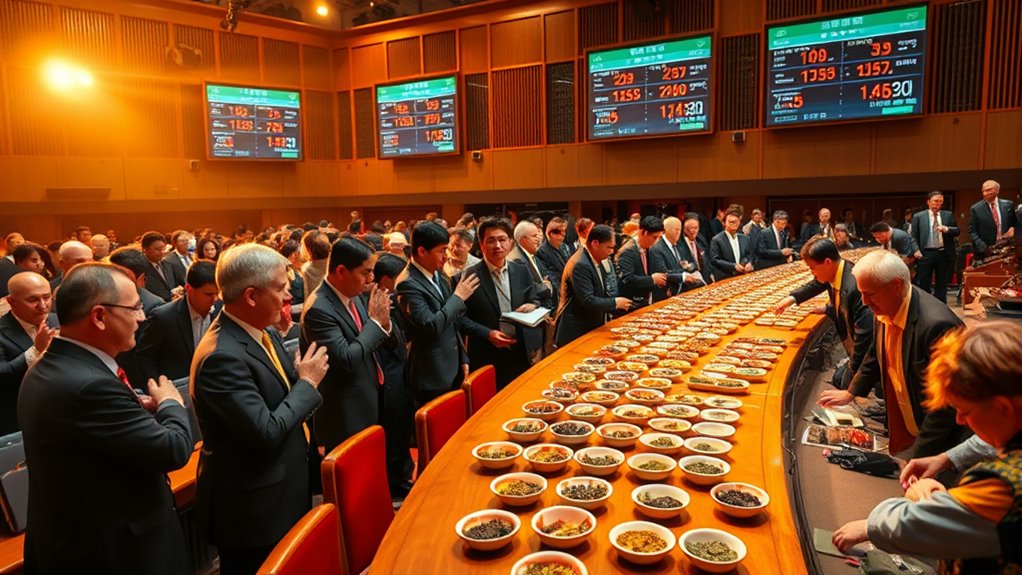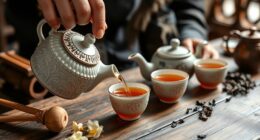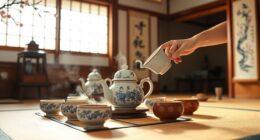In tea auctions, prices fluctuate quickly due to competitive bidding, driven by supply, demand, and buyer interest. Buyers use strategies like aggressive or conservative bids, which can lead to price spikes or drops. This environment is more volatile compared to direct trade, where private negotiations create more stable prices. Understanding these dynamics helps you grasp market behavior and factors influencing tea value. Keep exploring to uncover how these market forces shape your tea purchasing strategies.
Key Takeaways
- Tea auctions are more volatile, with prices driven by competitive bidding, unlike the more stable prices in direct trade negotiations.
- Bidding strategies and market dynamics significantly influence auction prices, whereas direct trade relies on negotiated, fixed prices.
- Auctions often result in short-term price fluctuations due to supply, demand, and bidder interest, contrasting with the steadiness of direct trade.
- Direct trade offers transparency and stability, while auctions can create price spikes and dips based on bidder behavior.
- Understanding auction volatility and bidding tactics helps market participants anticipate price movements versus the predictable nature of direct trade.

Have you ever wondered how the price of your favorite tea is determined? When it comes to tea auctions, the process can seem complex, but understanding it can give you insight into the economic forces at play. One of the key factors influencing prices at auction is pricing fluctuations, which happen due to various market dynamics. These fluctuations are driven by supply and demand, quality of the tea, and buyer interest, all of which can shift rapidly. Bidders at these auctions employ different bidding strategies to try to secure the best deals while maximizing value. Some might start with conservative bids, waiting for others to reveal their interest, while others might bid aggressively early on to set a high price and discourage competition. Your understanding of these strategies can help you grasp why prices can sometimes soar unexpectedly or fall back to more reasonable levels.
At auctions, prices aren’t fixed; they’re the result of competitive bidding. When a new lot of tea is presented, bidders analyze the quality, origin, and current market trends, then decide how much they’re willing to pay. This decision is influenced by their own valuation and their perception of what others might bid. The interplay of these perceptions leads to bidding fluctuations that can make auction prices unpredictable. If multiple bidders see high value in the same lot, they might engage in a bidding war, pushing the price well above the initial estimate. Conversely, if interest wanes, the price can drop, sometimes below the tea’s intrinsic worth. Your role as a bidder or observer means paying close attention to these dynamics, recognizing that each bid reflects a strategic move aimed at securing the tea at the best possible price. Additionally, understanding the concept of vertical storage solutions can help traders organize their inventory to better respond to market changes.
In comparison to direct trade, where prices are often negotiated privately and based on long-term relationships, auctions introduce a more volatile but transparent marketplace. The bidding strategies used during an auction can lead to short-term pricing spikes or dips that aren’t as common in direct trade deals. While direct trade can offer stability, auctions generate a lively, competitive environment where prices are constantly in flux. This volatility can be advantageous for sellers seeking top dollar or buyers hunting for rare or high-quality teas at potentially lower prices. Overall, understanding how pricing fluctuations and bidding strategies influence auction outcomes helps you appreciate the dynamic nature of tea markets and the factors that ultimately determine the final price of your favorite brew.
Frequently Asked Questions
How Do Tea Auction Prices Fluctuate Seasonally?
You’ll notice tea auction prices fluctuate seasonally due to seasonal price cycles influenced by weather impacts. During harvest seasons, prices tend to rise as fresh, high-quality teas become available. Conversely, in off-season periods, prices often dip because of limited supply. Weather conditions like droughts or heavy rains can also disrupt harvests, causing unpredictable price swings and emphasizing how seasonal changes directly affect auction prices.
What Factors Influence Bidders’ Strategies at Tea Auctions?
Juxtaposing the chaos of bidding with calm valuation strategies, you influence bidder behavior at tea auctions. Factors like quality assessments, market demand, and auction timing shape your strategies, prompting you to adjust bids accordingly. You weigh the tea’s worth against competitors’ actions, balancing risk and reward. Understanding these influences helps you refine your approach, ensuring you make informed decisions that maximize value while steering through the competitive auction environment.
How Transparent Are Tea Auction Bidding Processes?
You might wonder about bidding transparency at tea auctions. Generally, these processes are quite transparent, with clear bidding procedures and public records. However, concerns about market manipulation can arise if bidders try to influence prices unfairly. While auction houses implement safeguards, some skepticism remains regarding the full transparency of bidding activities. Staying informed helps you understand how fair and open the auction environment truly is.
What Are the Environmental Impacts of Tea Auctions?
Imagine a lush tea garden, vibrant yet vulnerable—this symbolizes the environmental stakes of tea auctions. You might not see the carbon footprint behind each bid, but these auctions can encourage sustainable practices by rewarding eco-conscious producers. Conversely, they can also lead to environmental harm if sustainability isn’t prioritized. Your choices influence how green or damaging the industry becomes, highlighting the importance of eco-awareness in the auction process.
How Do Auctioned Teas Reach International Markets?
You see auctioned teas reach international markets through a process involving tea grading and auction logistics. First, the tea is graded based on quality, which influences its value. Then, it’s transported through auction logistics, where it’s sold to buyers worldwide. These buyers often arrange shipping, ensuring the teas are delivered to various global markets, allowing consumers everywhere to enjoy high-quality, graded teas from different regions.
Conclusion
Ultimately, understanding the economics of tea auctions versus direct trade is like choosing between sailing with the wind or steering your own course. Auctions can bring lively market energy, but direct trade offers steady control and trust. By knowing the strengths and weaknesses of each, you can navigate your tea journey more wisely. Remember, whether you ride the stormy seas of auctions or chart a calm, direct path, your choices shape the future of your tea trade voyage.










